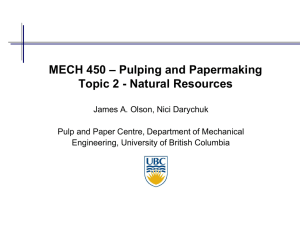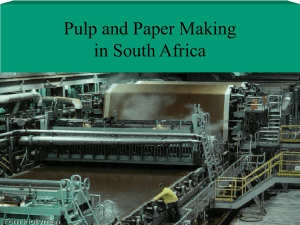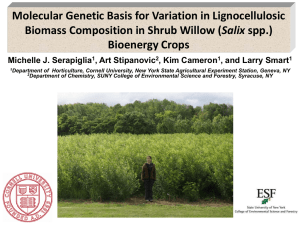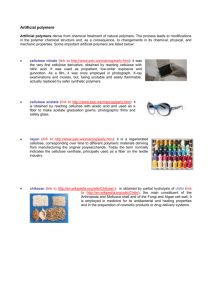Determinations of the Colloidal Structure of Pulp Fibres by Adsorption
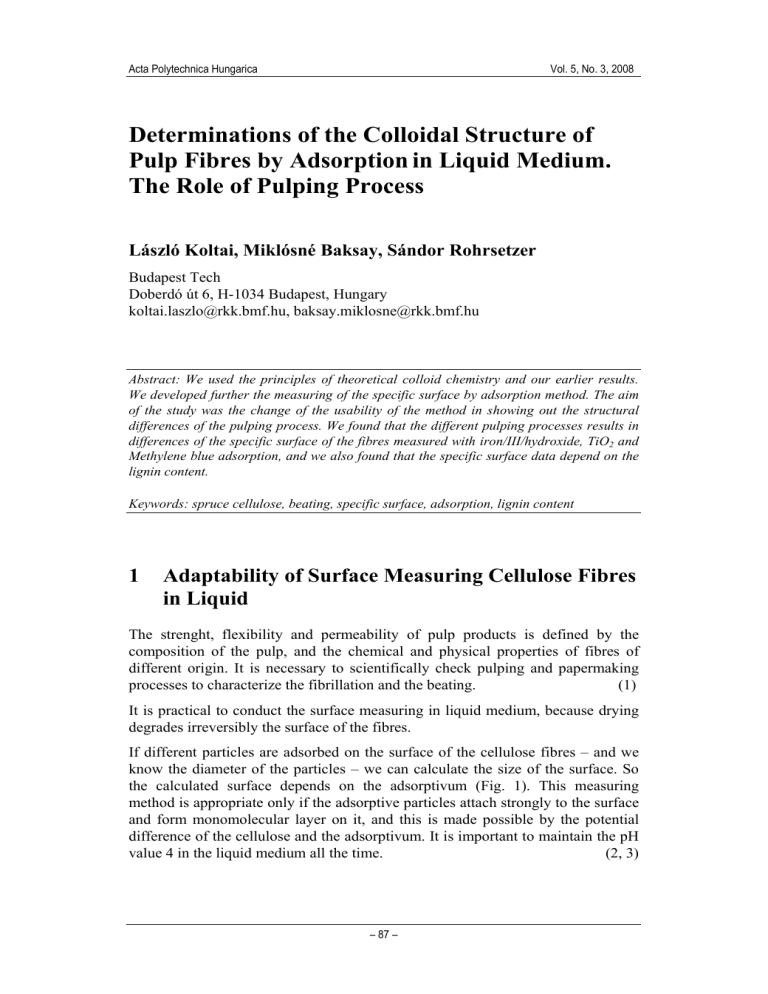
Acta Polytechnica Hungarica Vol. 5, No. 3, 2008
Determinations of the Colloidal Structure of
Pulp Fibres by Adsorption in Liquid Medium.
The Role of Pulping Process
László Koltai, Miklósné Baksay, Sándor Rohrsetzer
Budapest Tech
Doberdó út 6, H-1034 Budapest, Hungary koltai.laszlo@rkk.bmf.hu, baksay.miklosne@rkk.bmf.hu
Abstract: We used the principles of theoretical colloid chemistry and our earlier results.
We developed further the measuring of the specific surface by adsorption method. The aim of the study was the change of the usability of the method in showing out the structural differences of the pulping process. We found that the different pulping processes results in differences of the specific surface of the fibres measured with iron/III/hydroxide, TiO
2
and
Methylene blue adsorption, and we also found that the specific surface data depend on the lignin content.
Keywords: spruce cellulose, beating, specific surface, adsorption, lignin content
1 Adaptability of Surface Measuring Cellulose Fibres in Liquid
The strenght, flexibility and permeability of pulp products is defined by the composition of the pulp, and the chemical and physical properties of fibres of different origin. It is necessary to scientifically check pulping and papermaking processes to characterize the fibrillation and the beating. (1)
It is practical to conduct the surface measuring in liquid medium, because drying degrades irreversibly the surface of the fibres.
If different particles are adsorbed on the surface of the cellulose fibres – and we know the diameter of the particles – we can calculate the size of the surface. So the calculated surface depends on the adsorptivum (Fig. 1). This measuring method is appropriate only if the adsorptive particles attach strongly to the surface and form monomolecular layer on it, and this is made possible by the potential difference of the cellulose and the adsorptivum. It is important to maintain the pH value 4 in the liquid medium all the time. (2, 3)
– 87 –
L. Koltai et al. Determinations of the Colloidal Structure of Pulp Fibres by Adsorption in Liquid Medium.
The Role of Pulping Process
Figure 1
The specific surface vs. the diameter of the particle
1.1 The Counterfeiter Influential Factors of the Specific
Surface
The cellulose fibres might have a structure that counterfeits the specific surface of different sizes and results in a seemingly large surface. For example: if the diameter of the micro fibre is smaller than the diameter of the adsorptivum, we measure larger surface.
2 The Materials and Methods of the Experiment
We used in the measuring spruce cooked with three different chemicals at different cooking temperatures (430-440 K) – and cooking times. The data of the pulping are summarized in Table 1.
There are differences in the chemical contents of the pulps. It is typical, that the cellulose content grows and the polios and lignin content diminishes by applying longer pulping time and by bleaching. In spite of the grate chemical difference it is still possible to compare the results of the adsorption, because in these cases the electrocinetical potential (Z-potential) is the most important parameter and its average value is 25.25 mV without significant deviation.
– 88 –
Acta Polytechnica Hungarica Vol. 5, No. 3, 2008
Type of the pulp
Table 1
The major data of the different pulp fibres after pulping
Chemical name concentr.
(g/dm
3
)
Cookin g time
(min)
Cellulose content tart. w/w
(%)
Polios content w/w (%)
Lignin content w/w (%)
Zpotential
(mV)
Na
2
SO
3
250 5 48.2 19.4 27.9 -26
Spruce chemical pulp CMP
Spruce half cellulose
Spruce cellulose
Spruce bleached cellulose
Na
2
SO
3
NaOH
Na
2
S
NaOH
Na
2
S
250
144
36
144
36
90 54.1 16.0 24.5 -23
135 71.4 14.1 10.6 -27
135 85.8 9.0 1.8 -25
We have already published the concrete measurement methods of the experiments.
The most important parameters of the measurement were the diameters of the particles. The diameter of Methylene blue is 0.77 nm, and we know that 1 mg
Methylene blue means about 1 m
2
surface. The diameter of iron/III/hydroxide is 4 nm, so 10 mg iron/III/hydroxide means 1.2 m
2
surface. The average diameter of
TiO
2 is 250 nm, 1000 mg TiO
2
it means 1.12 m
2
surface. Considering the molecular weight of the adsorptiums, we can calculate the surface of the cellulose.
(3, 4) m
σ
=
V
⋅
( C k
−
C e
) m
(Eq. 1)
Where:
V: volume of the suspesion
[ dm
3 ]
C k
: concentration of the solution before the adsorption
[ mol/dm
3 ]
C e
: concentration of the solution after the adsorption,
[ mol/dm
3 ] m: weight of the cellulose
[ g
] m
σ
: weight of the adsorptioned particles
[ mol/g
]
S
=
m
σ
⋅
N
⋅
S
0
(Eq. 2)
Where: m
σ
: weight of the adsorptioned particles
[ mol/g
]
N: Avogadro- Loschmidt number
[
6
.
10
23
db particle/mol
]
S o
: surface of one adsorptioned particle
[ m
2
/1db particle
]
S: specific surface
[ m
2
/g
]
(5, 6)
– 89 –
L. Koltai et al. Determinations of the Colloidal Structure of Pulp Fibres by Adsorption in Liquid Medium.
The Role of Pulping Process
The chemical content measurement of the cellulose fibres were made according to the Hungarian standards.
Cellulose and incrusting substances content: MSZ.53.97 (1988), Lignin content:
MSZ.8234. (1987) (7, 8, 9)
3 Results of the Experiments
Examining the spruce samples, we described the growing cooking degree with diminishing lignin content. The specific surface data depend on the lignin content as illustrated in Fig. 2.
100
80
60
Mblue
TiO2
Fe
MK
40
20
0
0
TiO2
Fe/III/-OH
10 20 30
Lignin Content % (W/W)
40
Figure 2
Methylene blue, iron/III./-hydroxide and TiO
2
specific surface of different pulps vs. lignin content
We can see in Fig. 1 that the Methylene blue specific surface diminishes with chemical pulping, but the iron-/III/-hydroxide- and Titan- dioxide specific surface grow.
We can assume that the different pores in the cellulose surface change with the changing of the cooking degree.
The Methylene blue surface value is an apparent value because the amorphous part of the fibres dissolves the pigments. The use of word ‘apparent’ is necessary in the case of Methylene blue according to our previous experiences. This is the explanation for the decreasing of specific surface when the content of incrusting substances and the lignin content diminishes.
During cooking and pulping there are opposing processes. While the amount of the incrusting substances diminishes, the dissolution of the pigments also reduces for new surfaces become accessible. The first process reduces the apparent surfaces, the second process enlarges it.
– 90 –
Acta Polytechnica Hungarica Vol. 5, No. 3, 2008
Comparing the results we can also calculate the surface of the different pores in the fibres (Table 2).
Table 2
Surfaces of the different pores of the spruce fibres
Name of the cellulose: lignin content % (W/W) molecular pore
0.4-0.8 nm subcolloidal pore
0.8-15 nm colloidal pore
15-420 nm
Spruce chemical pulp
CMP
27.9
Spruce half cellulose
24.4
Spruce cellulose
10.6
Spruce bleached cellulose
1.8
6 15 37 45
60 66 24 0
10 12 24 30
We can see in the above table that the specific surface of the molecular pores grows while the subcolloidal surfaces diminish by increasing the cooking degree.
Conclusion
In the course of the laboratory tests surfaces of different grades of spruce cellulose fibres beaten to different extent and cooked in different ways were determined using the molecular Methylene blue, iron/III/-hydroxide and TiO
2
adsorption method in liquid medium.
The Methylene blue specific surface diminishes with chemical pulping, but the iron-/III/-hydroxide- and Titan- dioxide specific surface grow. We can assume that the different pores in the cellulose surface change.
The specific surface of the molecular pores grows but the subcolloidal surfaces diminish as we increase the cooking degree.
References
[1] Rohrsetzer S., Kabai-Faix M., Völgyi O., Kovács P.: Cellulóz rostok felületvizsgálatai, in Papíripar 29(5):pp. 35-37
[2] S. Rohrsetzer, P. Kovács, M. Kabai-Faix: Specific Surface of Pulp Fibres in Proceedings of Cellulose Chem. and Technology 1995(7):pp. 159-165
[3] Nevell T. P., Zeronian S. H.,: Cellulose Chemistry and Applications, Ellis
Horwood Limited, 1987 Chichester.:pp. 96-101
[4] Rohrsetzer S., Annus S., Erdélyi J., Baksay M-né., László K.,
Cellulózrostok kolloidkémiai szerkezete I., in Magyar Kémiai Folyóirat
105(3):pp. 83-89
[5] Rohrsetzer S., Annus S., Erdélyi J., Baksayné., Koltai L., Cellulózrostok kolloidkémiai szerkezete II. in Magyar Kémiai Folyóirat 106(3):pp. 106-
112
– 91 –
L. Koltai et al. Determinations of the Colloidal Structure of Pulp Fibres by Adsorption in Liquid Medium.
The Role of Pulping Process
[6] Koltai L., Borbély E-né, Erdélyi J., Papíripari rostanyagok kolloidkémiai szerkezetének vizsgálata víz közegben, színezékrészecskék adszorpciójával, in Anyagvizsgálók Lapja, 16(1):pp. 56-59
[7] A cellulózok lúgoldhatóságának meghatározása MSZ 5398:1988, Magyar
Szabványügyi Testület
[8] Papíripari rostos nyers-és alapanyagok lignintartalmának meghatározása
MSZ 8234:1987 Magyar Szabványügyi Testület
[9] A cellulózok lúgállóságának meghatározása MSZ 5397:1988, Magyar
Szabványügyi Testület
– 92 –
